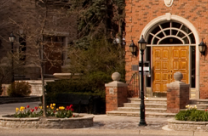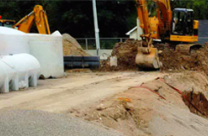Posted Sat, 04/25/2015 - 14:04 by L. Robert McEwen
This past winter we have noticed an increase in foundation damage and, in particular, more than usual damage to some foundations of unheated structures such as residential garages. You may have heard the term “frost heave” and are aware that it can damage the foundation of a structure. The following is a brief discussion of the cause and effect of the science behind this phenomenon.
It was originally thought that frost heave occurred as the volume of the soil increased when water in the soil changed to ice. It is now known that a phenomenon known as ice lensing causes “frost heave”. As frost penetrates the ground, water is drawn from unfrozen soil below up to the freezing zone where it solidifies to form layers of ice, or lenses, forcing soil particles apart and causing the soil surface to heave.
Researchers have reported ice lenses over 4 inches thick. When this phenomenon occurs under a shallow footing, it lifts the footing and can cause serious damage to the footing and the structure supported on the footing. In the Spring, when the ice lens melts, water dissipates in the soil and the void created by the ice lens collapses. This can result in the foundation dropping to a different elevation from that prior to the frost heave.
Damage to foundation walls typical of the effects of frost heave have been reported where the foundation is well below the depth of frost penetration thus eliminating frost heave as the cause of the foundation movement. We now know that such damage to a foundation can occur as a result of “adfreeze”. This is a condition where frost heave occurs beside a foundation wall rather than under the footing, and where the ground is frozen to the side of the foundation wall. As the ground beside the foundation heaves, it can lift the wall it is frozen to. This “adfreeze” condition can fracture a foundation several feet below grade and lift the upper part of a foundation wall off the lower part of the foundation wall and footing.
Frost heave and/or adfreeze occurs only where three specific conditions exist. The soil must be “frost susceptible” which has a high concentration of fine soil particles such as silty loam. There must be water in the ground which can migrate upward through the frost susceptible soil by capillary action and, lastly, cycled freezing of the ground must occur. Take away any one of the above conditions and frost heave and/or adfreeze will not occur.
- L. Robert McEwen's blog
- Login to post comments





